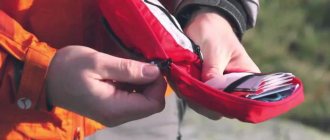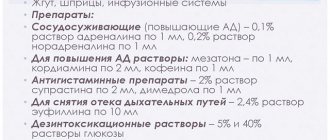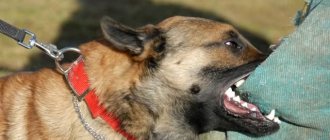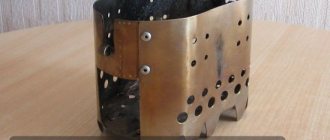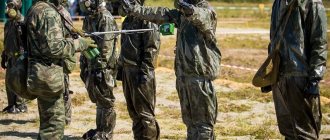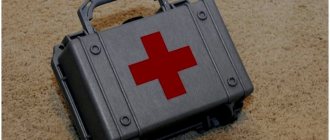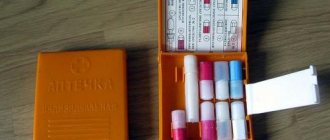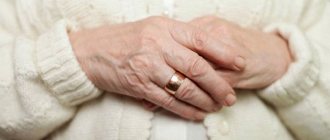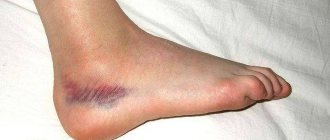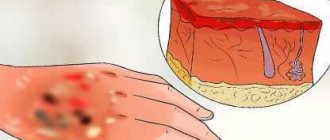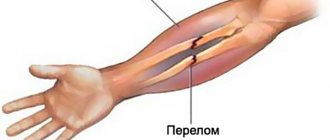Camping first aid kit
On a long hike you will need not one, but 2-3 first aid kits, varying in composition and purpose. The basic first aid kit is taken one per group and contains a comprehensive set of medications to solve almost any health problem. All members of the camping trip should know who keeps it and what it looks like. In addition, other medical kits are being formed.
Individual medical package
An individual medical package is needed if you are behind the group and have lost access to the main first aid kit. Dressing materials, a tourniquet, hydrogen peroxide, iodine, analgesics and antipyretics, sorbents, nitroglycerin, as well as medications that you should regularly take as prescribed by your doctor are placed there. These may be inhalers, antihypertensives, and hypoglycemic drugs.
Small travel first aid kit
A small tourist first aid kit is collected if you go on a short hike in a small group. This mini-kit contains all the medicines and medical devices, as in a regular first aid kit, but in a smaller volume, designed for 2-3 days.
Emergency kit
It is better to collect an emergency first aid kit separately from the main one to make it easier to find medications. It includes dressing materials, nitroglycerin, capoten, ammonia, tourniquet, antiseptic, alcohol wipes, syringes and some injections: adrenaline, dexamethasone, suprastin, cerucal, analgin.
Advice!
It is not always possible to purchase potent drugs like adrenaline at a pharmacy without a prescription. In this case, it is recommended to visit a doctor and ask to prescribe these medications, explaining their purpose.
First aid kit for a hike, on a trip, to the country. Composition of a first aid kit
Share:
At the request of workers, I am publishing the composition of a traveling first aid kit, which was compiled for the “Wanderer”, and very soon will be included in the book “Medicines” of the “Health Academy” project.
First aid kit for a hike, on a trip, to the dacha
For many years I have been “managing” the medical section on an Internet portal for tourists. For more than ten years, I have sifted through a bunch of literature related to providing self- and mutual assistance in camping conditions, and answered several hundred questions. Many questions related specifically to the first aid kit that is appropriate to take on a hike. Finally, tired of explaining for the twentieth time why you shouldn’t take validol from the heart, I decided to compile my own scientifically based version, which I bring to your attention.
This first aid kit is designed for tourists who travel far from home and do not have the opportunity to quickly get to a medical facility. Of course, if we are talking about a trip to the country, then the list of medications can be reduced within reasonable limits.
I divided the list of medications into three groups: A, B and C. List A is recommended drugs, list B is drugs that are desirable (but not necessary) to have with you, but list C is unnecessary drugs that you should not take need to. Why did I separate them into a separate group? The fact is that there are standard misconceptions that are replicated from one reference book to another. So “list B” is a list of misconceptions.
- This first aid kit is considered as a basic one, available for use by non-professionals. Specialists are free to re-equip it according to their own understanding and taking into account their experience and knowledge, which can be many times greater than that of the author.
- Based on point 1, this first aid kit does not contain drugs in ampoules, suture material, etc.
- A certain proportion of accidents cannot be treated in field conditions or require professional knowledge and equipment.
- It is advisable for the trek leader and the participant responsible for the group’s medical care to warn participants about the need for preventive visits to doctors (including the dentist) and the formation of an individual first aid kit for the treatment of chronic diseases (hypertension, ulcers, asthma, etc.)
- Dosages of drugs are used according to the instructions for use.
- The author recommends the possibility of emergency telephone contact with a doctor for advice on the use of certain drugs (for example, antibiotics), as well as tactics in emergency situations.
- The contents of the first aid kit can be expanded depending on the conditions of the route (high mountains, lack of water of proper quality, etc.)
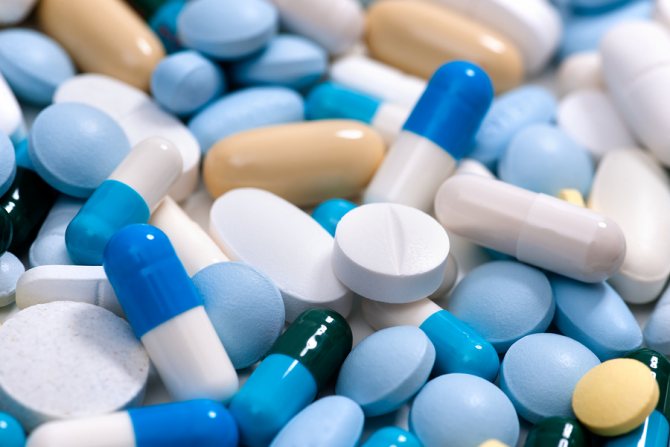
List A. Preparations and materials RECOMMENDED for completing a first aid kit
1. Antibiotics
- Amoxicillin/clavulanate (amoxiclav, augmentin) – for the treatment of pulmonary infections, infections of the ENT organs, as well as massive traumatic injuries with suppuration. We discussed the clinical manifestations of these diseases in the corresponding section. Duration of treatment is 5-7 days.
- Ciprofloxacin (Ciprobay) or another fluoroquinolone (ofloxacin, norfloxacin) - for the treatment of urological (acute cystitis) and severe intestinal infections. Acute cystitis is a common pathology that occurs in women due to hypothermia. Diagnosis is based on the symptoms of urinary disorder (they are well known to most women), and, contrary to popular belief, the diagnosis does not require laboratory confirmation. For treatment, a short course (3-5 days) of fluoroquinolones is used.
Antibiotics are prescription drugs, therefore, if possible, it is recommended that the prescription of an antibiotic, even in field conditions, be coordinated with a doctor.
2. Nonsteroidal anti-inflammatory drugs (NSAIDs) – universal painkillers and anti-inflammatory drugs.
- Paracetamol is primarily an antipyretic drug.
- Diclofenac (Voltaren) or celecoxib (Celebrex) are effective pain relievers. Celebrex is preferred for patients with gastrointestinal diseases.
It is possible to replace it with other drugs (ketoprofen, ibuprofen, etc.). All drugs are used in tablets. Local forms of NSAIDs are not sufficiently effective and are considered placebo. Injectable forms, as a rule, are not superior to tablets in effectiveness, however, when administered in field conditions, the risk of infectious complications at the injection site increases.
3. Antihistamines (anti-allergic)
- Loratadine (Claritin) or another modern drug (Erius, Telfast, etc.)
4. Antidiarrheals (in case of poisoning)
- Smecta, activated carbon, enterosgel or other drugs listed in the appropriate section.
The use of loperamide (imodium) for poisoning is undesirable, because This drug interferes with the removal of toxins from the intestines.
5. Antiseptics for external treatment of wounds
- Chlorhexidine or Miramistin in plastic packaging
6. Local antibiotics for the treatment of purulent wounds
- Levomekol
7. Dressing materials
- Bandages/gauze
- Elastic bandage
- Rolled plaster, bactericidal plasters
- Scissors
- Tweezers
List B. Preparations and materials, the presence of which is POSSIBLE in the first aid kit. Tourists, as you know, try to save on every gram of cargo. The absence of these drugs is not tragic, but their availability at the right time can make life a lot easier.
1. Antiherpetic drugs (for herpes on the lips)
- Acyclovir (Zovirax) or valacyclovir (Valtrex)
The combination of hot sun and low temperatures, for example in the mountains, very often provokes the appearance of a herpetic rash on the lips. Contrary to annoying advertising, topical lip creams are practically ineffective against developing herpes. If you really want to stop the appearance of rashes and ulcers on the lips, antiviral drugs must be taken in tablets. The main condition is that treatment should be started on the first day (preferably in the first hours) from the moment itching and redness appear.
2. Antacids and acid blockers (symptomatic treatment of heartburn and other symptoms of hyperacidity)
- Maalox or phosphalugel
- Omeprazole (losec, omez) or analogue
3. Oral rehydration salts (fluid replacement for severe vomiting/diarrhea)
- Regidron
4. Topical steroids (treatment of local allergic reactions, such as insect bites)
- Lorinden
5. Antispasmodics
- No-shpa
However, you remember that there can be many causes of abdominal pain.
6. Remedies for the common cold
- Xylometazoline (halazoline)
7. Enzyme preparations
- Creon, etc.
Just in case of overeating. But promise me it won't become a habit.
8. Eye drops and ointments for the treatment of conjunctivitis
- Tobradex
- Levomycetin ointment
9. Expectorants
- Ambroxol (lazolvan)
10. Local antiseptics (for treating the skin around the wound)
- Iodine
A truism: you cannot “fill” a wound with iodine! In addition to the main damage, you will also receive a chemical burn. Forget about brilliant green, it is almost never used in the world anymore, since its disinfecting effect is very small.
11. Products for treating skin for superficial burns (including sunburn)
- Panthenol
12. Remedies for motion sickness
- Dramamine
13. Digital thermometer (mercury-free). I'm surprised that in the 21st century anyone still uses old mercury thermometers.
14. Device for removing ticks. A very useful thing. Can be purchased online.
List B. Drugs and materials NOT RECOMMENDED in the first aid kit (the harm exceeds the benefit or there is no proven effect).
1. Levomycetin, phthalazole for intestinal infections: highly toxic and ineffective drugs
2. Valocordin, Corvalol: alcohol solution of phenobarbital. The harm far outweighs the benefit.
3. Validol: mint dummy candy.
4. Nitroglycerin: dangerous in inexperienced hands; in an unfamiliar person it can cause a drop in blood pressure and a headache.
5. Biseptol: very toxic.
6. Furacilin: very weak antiseptic effect. Currently not in use.
Of course, the listed list of drugs is indicative, and you are free to make reasonable changes to it: the closer the medical institution is to your place of rest, the smaller this list will obviously be. We have been discussing this list for more than a year among colleagues and tourists; perhaps I can guarantee that if you take everything listed with you, you will not be left without help in case of traditional ailments. And of course, we are not talking about self-help for serious injuries, cardiovascular accidents and surgical diseases.
Basic composition of a first aid kit
The basic composition of a first aid kit includes medications that you cannot do without on any trip. This is the bare minimum you need to take with you.
Disinfectants, antiseptics
Disinfectants that are convenient to use and do not require additional dilution are miramistin, chlorhexidine 0.2-0.5%, hydrogen peroxide 3%. The latter also helps to quickly stop bleeding. As a rule, it is enough to take with you a couple of bottles of Miramistin and one bottle of peroxide (depending on the number of tourists and the duration of the hike); iodine and brilliant green are not needed in this case.
Dressing materials
Mandatory dressing materials include sterile and non-sterile bandages, cotton wool, and gauze wipes. It is better to take bandages with a reserve, different in width. The packaging with cotton wool must also be sterile.
Painkiller and antipyretic
The most universal drugs that work effectively both as an antipyretic and as an analgesic are aspirin (acetylsalicylic acid), nurofen (ibuprofen), nimesil.
Remedies for gastrointestinal problems
The first aid kit must have everything you need that can improve the condition of the digestive tract. This is at least 10 tablets of antiemetic (cerucal), antidiarrheal (loperamide), laxatives (senade), as well as medications that relieve spasms from internal organs (no-spa, drotaverine).
Basic drugs by group
A traveler's first aid kit should contain the essentials that a person might need if he gets sick or feels unwell. It should include drugs from several pharmacological groups.
Painkillers
It is possible that on vacation you will get a headache, a toothache, or that chronic diseases will worsen, which will require you to take painkillers. They will also help relieve the first signs of a cold or relieve muscle pain as a result of long walks or swimming.
Among the painkillers in a tourist’s first aid kit, you can put the following drugs:
- Ketanov;
- Spasmalgon;
- Pentalgin.
To relieve abdominal pain due to intestinal dysfunction, you must have No-shpa with you . It will also help improve the condition of menstrual pain in women.
Gastrointestinal
Disorders of the gastrointestinal tract are the most common diseases of travelers. They are caused by changes in climate and time zone, food and water. To normalize the functioning of the gastrointestinal tract, you will need medications for diarrhea, stomach disorders and absorbents:
- Imodium, Loperamide – against diarrhea;
- Activated carbon, Polysorb – absorbents;
- Festal, Pancreatin, enzymes;
- Linex, Bifiform - probiotics.
Absorbents will come to the rescue when dealing with food and alcohol.
Wound healing
Antiseptics and wound healing agents, as well as for dressing wounds, should be in the traveler's bag. To immediately treat the wound and bandage it, you must have:
- bandage;
- iodine;
- hydrogen peroxide;
- adhesive plaster;
- wound healing ointment – Boroplus.
Anti-cold and antiviral
You can become infected with a virus or catch a cold at any time of the year and in any country. It is important to quickly relieve symptoms to prevent further development of the disease.
For this you will need:
- Acetylsalicylic acid;
- Fervex;
- Coldrex;
- Nimisil;
- for sore throat – Ingalipt, Hexoral, Grammidin;
- vasoconstrictor nasal agents - Rinostop, Nazivin, Nazol, Otrivin;
- cough tablets and syrups - Mucaltin, Ascoril, Gerbion, Flavamed.
If you are very unwell, it is better to stay in bed for the first day, otherwise the symptoms of a cold will intensify and the vacation will be completely ruined.
Antihistamines
Changes in climate and food can cause allergic reactions. The following will help you cope with them and normalize your condition:
- Cetirizine;
- Loratadine;
- Tavegil;
- Cetrin;
- Claritin;
- Suprastin.
If there are allergy sufferers in the family, when packing a first aid kit for vacation, you need to put several tablets of different antihistamines in it.
Antipyretics
Body temperature can increase not only with a cold, but with toothache and muscle pain, sunburn, heat stroke, poisoning and other diseases.
A traveler's first aid kit should have any antipyretic agent:
- Paracetamol;
- Nimisil;
- Acetylsalicylic acid;
- Solpadeine.
In addition to these medications, you should put an electronic thermometer in your first aid kit to measure body temperature.
Products for safe tanning and burns
For tourists who are going on a beach holiday, it is useful to know what to take in a travel first aid kit for safe tanning and against burns in case it was suddenly not possible to protect the skin from ultraviolet radiation in a timely manner.

Panthenol is recognized as the most effective . It soothes and cools damaged skin, promotes its rapid regeneration.
Before going outside, you must apply sunscreen with an SPF of at least 30 . It is necessary to protect not only the body, but also the skin of the lips from sun rays. Reliably protects lipstick with SPF markings; products from Nivea or Neutrogena are suitable.
Anti-sickness remedies
For travelers prone to motion sickness, special means are needed. To avoid the discomfort, dizziness, nausea and vomiting that occurs with motion sickness, find out which pills to take when traveling. The following drugs are effective against motion sickness:
- Daedalon;
- Dramamil;
- Dramamine;
- Bonin;
- Elenium.
Many people use a motion sickness bracelet instead of pills . Its effectiveness in acupressure. The bracelet presses on the points responsible for the functioning of the nervous system and internal organs. It begins to act 2-3 minutes after it is put on and is absolutely safe.
Insect repellents
During active recreation, insects can disturb, leaving bites on the body and causing discomfort to tourists. Most of all, mosquitoes annoy humans. These insects are sensitive to odors; they are repelled by the aromas of clove, citronella, valerian, eucalyptus, lavender, geranium, mint, anise, camphor and cedar oils.
At the pharmacy you can buy special repellent patches and bracelets with essential oils . Up to 6 patches can be applied to the body of an adult at once, the protection will last for about 12 hours.
It is worth taking with you aerosols or patches Insectblock and Gardex against insects while relaxing.
Drugs for chronic diseases
There should be no question about what medications to take with you on a trip if you have chronic illnesses. They are prescribed by your doctor and taken either regularly or during exacerbations.
The list of medications for the first aid kit of a tourist who often suffers from sore throat, sinusitis, bronchitis and other chronic respiratory diseases should include antibiotics prescribed by a specialist.
Recommended contents of a first aid kit
As a rule, the list of drugs in a first aid kit for a trip is more impressive, because it is quite difficult to predict in advance what problems tourists will encounter.
For mechanical injuries: dressings
For open wounds, sterile bandages and cotton wool, as well as gauze pads, are useful. For closed fractures and dislocations, non-sterile bandages are needed, with which an immobilizing splint is attached to the limb.
For sprains
In case of sprained ligaments and muscles, elastic bandages are indispensable, which reduce the load on the affected limb. An elastic bandage should be equipped with 1-2 fasteners so that it does not unravel along the road and maintains sufficient tension.
For internal infections
To combat infectious diseases, antibacterial agents are needed. They should be used when:
- The appearance of purulent (yellow-green) discharge from the new sinuses or bronchopulmonary system;
- Signs of cystitis, urethritis - frequent painful urination;
- Intestinal infections, poisoning with poor quality products.
It is better to choose antibiotics with a broad spectrum of action (amoxicillin, levofloxacin, azithromycin) and take them in full course. Azithromycin is especially convenient in this regard. It is active against most microbes, and you only need to take 1 tablet for 3 days.
Note!
Under normal conditions, antibiotics are recommended to be taken only as prescribed by a doctor. But if you are on a long hike and do not have the opportunity to get a consultation with a doctor in the near future, then you cannot postpone treatment. This can lead to serious complications - pneumonia, sinusitis, pyelonephritis.
Disinfectants for external use
To the drugs listed above - miramistin, chlorhexidine, hydrogen peroxide - you can add brilliant green or iodine. It is most convenient to use them in the form of markers. You can also find special iodine on sale in the form of glue, which forms a film on the surface of the wound that protects against bacteria and dirt.
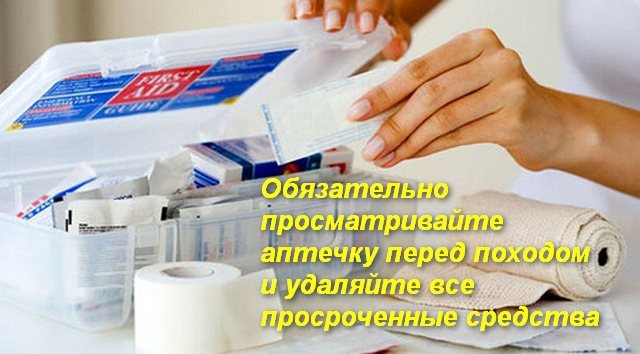
For allergies
Be sure to take antihistamines on your hiking trip: Suprastin, Tavegil, Erius, Zyrtec. They are drunk when skin rashes or allergic rhinitis appear. If life-threatening allergic reactions occur (Quincke's edema, anaphylactic shock), then you need to use hormonal drugs in injection form (dexamethasone), stop the hike and seek medical help as quickly as possible.
For eye diseases
In case of infectious and inflammatory eye diseases, you should take eye drops (sodium sulfacyl - Albucid, Tobradex or Tobrex) and ointments (ofloxacin) when traveling. Tobrex and Tobradex contain the same antibiotic, but the latter additionally contains a hormonal component that reduces tearing, redness and swelling of the eyelids.
Antipyretics
The main antipyretics needed on a hike: aspirin, ibuprofen, paracetamol. Be sure to take several different medications. In total there must be at least 5 drug standards: for example, you can pack 20 tablets of aspirin and paracetamol and 10 tablets. ibuprofen.
Antimalarial drugs
Anti-malaria drugs (bigumal, quinine) are needed only when traveling to countries with warm climates. You should make inquiries about the prevalence of malaria in a certain area in advance.
Painkillers
Classic analgesics include analgin, baralgin, dexalgin, ketorol. They are available in the form of tablets or ampoules. These medications should not be abused. Use them only for severe headaches or toothaches, injuries and bruises.
With a runny nose
In case of severe nasal congestion or the development of sinusitis, it is allowed to use vasoconstrictor drops and nasal sprays. These are xymelin, snoop, naphthyzin, sanorin, vibrocil. Try to use them for no more than 5 days.
For burns
To provide first aid for burns, the first thing you need is a cooling ice pack. Then the skin over the burn is treated with one of the following products: bepanten plus, panthenol, baneocin. They speed up healing and prevent infectious complications. Therefore, your first aid kit should have at least 1 cream, gel or aerosol with a similar effect.
In case of poisoning
In case of food or chemical poisoning, first of all, you should take enterosorbents (Polysorb, activated carbon, smecta) and start a course of intestinal antibiotics (alpha normix, chloramphenicol). It is also possible to use antiemetic, fixative, antipyretic drugs.
For diarrhea
If you have repeated loose stools, you should immediately start taking sorbents and not stop them until the diarrhea stops. If they are ineffective, you can additionally take Imodium (loperamide). It is available in an easy-to-take on-the-go form—orosoluble tablets.
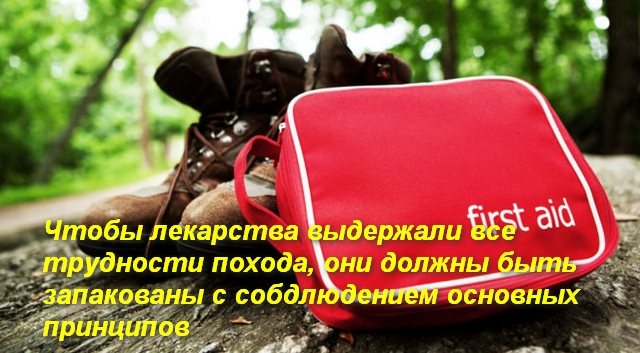
Laxative
The most fast-acting laxatives include bisacodyl and senade. If there is no effect from their use, then you can use microenemas. Taking regular cleansing enemas on a hike is not very convenient and, as a rule, impractical.
For heart diseases
The main drug for chest pain is nitroglycerin in tablets or aerosol. For emergency treatment of high blood pressure, capoten (captopril) is used. Corvalol, validol, valocordin have a weak effect on heart pain and are used mainly as sedatives.
For frostbite
If frostbite occurs, you may need analgesics, antihistamines and wound-healing ointments (bepanten, panthenol), as well as dressings (if there are blisters).
Ampoule preparations
Anti-shock kit
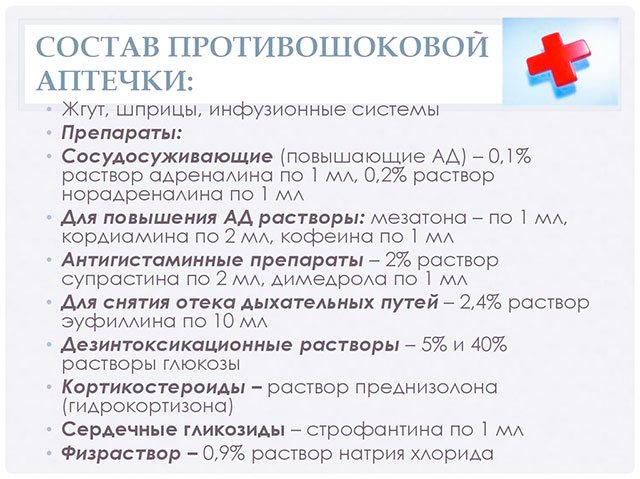
Painkillers: 1. TRAMAL – non-narcotic analgesic, anti-inflammatory, antipyretic, has an anti-shock effect. Available in ampoules of 2 ml. It is used for intense pain due to injury, intractable angina, burns, and various types of shock. Used for intramuscular injection 1-2 ml 2-3 times a day. 2. BARALGIN (maxigan, spasgan, spasmalgon) – an anesthetic that has an antispasmodic effect (renal, liver, intestinal colic - relieving spasms). Available in ampoules of 5 ml. It is used intramuscularly 2-3 times a day, or intravenously 3-4 times a day (depending on the intensity of pain). 3. NOVOCAINE (0.5%) – local anesthetic – for local anesthesia. Available in ampoules of 2, 5, 10 ml. Administered orally, subcutaneously, intramuscularly. Indications: angioneuralgia, toothache, burns of the eyes, skin, pharynx, esophagus, trauma, scorpion stings, traumatic shock. Antihistamines, anti-inflammatory drugs: 4. PREDNISOONE (hydrocortisone, dexamethasone) – a hormonal drug that has an anti-inflammatory, anti-allergic effect, and has an anti-shock effect. Available in ampoules of 30 mg (1 ml) RESUNCTION KIT! Indications: bronchial asthma (severe attack), botulism, anaphylactic allergic reaction, allergic edema of the upper respiratory tract (Quincke's edema), collapse (decreased pressure), poisoning, aspiration syndrome, severe intoxication accompanied by impaired liver and kidney activity (hepatorenal failure ), snake bites, scorpion stings. Contraindications: diabetes, severe arterial hypertension. It is used intramuscularly or intravenously at 30 mg. It is administered intravenously in a dilution with saline or glucose. 5. TAVEGIL (suprastin, diphenhydramine, pipolfen) – has antiallergic, sedative, anti-inflammatory, antiemetic effects. Available in 1 mg tablets and 2 ml ampoules containing 2 mg of the drug. Take 1 mg orally (1 tablet) repeatedly. 2 mg is administered intramuscularly. Cardiotropic (cardiovascular) drugs: 6. CORDIAMINE - improves the functions of the cardiovascular system and breathing during shock, asphyxia, poisoning, infection, stimulates the activity of vital centers, increases blood pressure. Available in ampoules of 2 ml. Used intramuscularly and subcutaneously in 2 ml doses. 7. ADRENALINE – RESUSCITATION DRUG – stimulates the cardiovascular system, increases the strength and frequency of heart contractions, increases blood pressure, relieves bronchospasm, is used in cardiac arrest. Available in ampoules of 1 ml of 0.1% solution. Used intravenously at 0.25-1 ml (for cardiac arrest). 8. EUPHYLLIN – a vasodilator, antispasmodic drug, used for bronchial asthma, shortness of breath, cerebrovascular accident, migraines, high blood pressure. Available in ampoules of 1 ml of 24% solution (240 mg). It is administered intramuscularly slowly. Adverse reactions: nausea, vomiting with rapid administration.
This is interesting: Disaster Scenario - Epidemic
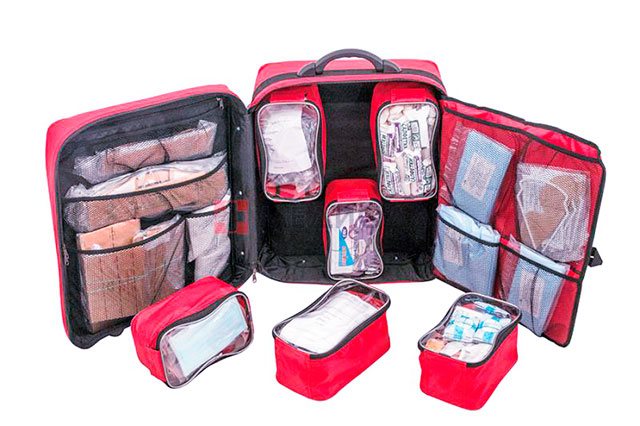
Preparations that have a plasma-substituting effect: 9. POLYGLUCINE (400 ml – bottle) – a solution of dextran that has a plasma-substituting effect. Used for injuries with massive blood loss, shock. Administered intravenously. Diuretics: 10. LASIX (fruzix, furosemide) – used for pulmonary edema, brain edema, and traumatic brain injury. Available in ampoules of 40 mg (2 ml). It is used intravenously or intramuscularly at 20-60 mg.
Sedatives: 11. RELANIUM is a sedative drug from the benzodiazepine group. Used as a sedative and hypnotic antidepressant. Available in ampoules of 10 mg. It is administered intravenously, intramuscularly. Monitoring the state of external respiration is necessary! Serums, toxoids: 12. TETANUS ANATOXIN – a prophylactic agent for infected wounds. See instruction insert.
Antibacterial drugs: 13 GENTAMICIN is an antibacterial agent, used for infectious diseases, wounds, injuries, and is a means of combating severe purulent infection. It is administered intramuscularly 2 times a day, 40-80 mg (depending on weight).
What to add to your first aid kit when traveling with a child
When planning a hike with a child, do not forget to slightly adjust the composition of the first aid kit to suit his needs. The main groups of medications are suitable for both adults and children. But there are exceptions. For example, drugs based on acetylsalicylic acid can lead to Reye's syndrome in children under 15 years of age. Therefore, they are only allowed to give paracetamol or ibuprofen as an antipyretic. In addition, some antibiotics (levofloxacin, amoxiclav) and antihistamines (fenkarol, tavegil, zodak) are prohibited in pediatric practice.
Proper packing of a first aid kit
In order for medications to withstand all the difficulties of a hike, they must be packaged in compliance with the following basic principles:
- Moisture resistance. Either the container itself must be waterproof, or it must be placed in a sealed bag. Ordinary polyethylene can protect a first aid kit from rain, but it will not save you if it falls into water.
- Rigidity. In a “suitcase” made of hard plastic, ampoules and tablets are more likely to remain intact when hit or dropped from a height.
- Thermal insulation. The first aid kit should be made of thermally insulating material or lined, for example, with foil. This is necessary to protect the contents from overheating and destruction of the active components of the drugs.
- Depreciation. On sale there are special hard packaging with shock absorbers that protect the drugs from shocks and impacts. If it is not possible to find such a convenient thing, then you can choose a rubberized container or line it with foam rubber.
- Division into cells. This way you can systematize medications according to their main effect and quickly find what you want. Each cell must be signed.
- Brightness of the packaging. A first aid kit should be immediately visible so as not to waste time searching for it among other things.
- Abstract to the drugs. In the first aid kit you need to put a list of medications, which will indicate the doses, frequency of administration and brief indications. For example, “for diarrhea” or “for heart pain.”
Checking expiration dates of medications
All medications must have a sufficient shelf life so that it does not run out during the hike. The shelf life is indicated not only on the cardboard box in which the product is sold, but also on each ampoule, blister, and jar. Be careful not to accidentally cut off the part with this data.
Be sure to look through your first aid kit before going and remove any expired items. At best, they will be ineffective, and at worst, they will be harmful to health.
Important!
Also take into account the storage features of medications. If the solution or capsules, which should be stored in a dark, cool place, have been left in the sun all day, they will lose their beneficial properties much earlier than the specified date.
What should you choose: a store-bought first aid kit or one you can assemble yourself?
Pharmacies can offer you a choice of ready-made travel first aid kits in convenient packaging with compartments. However, there are important nuances:
- The list of medications in such collections is far from complete; it mainly includes dressings and medical instruments. Medicines have to be purchased additionally.
- Individual characteristics are not taken into account. Manufacturers of first aid kits cannot know what diseases their potential buyer suffers from, so you will have to take care of personal medications yourself.
- Packaging does not always meet all requirements. It can be soft, not airtight, without a thermal insulation layer.
Thus, it makes sense to purchase a ready-made tourist first aid kit if its packaging is convenient and safe, but you will still have to purchase medicines in accordance with the individual needs of each member of the group on your own.
Hunter's First Aid Kit
FIRST AID KIT FOR HUNTER AND FISHER, “PLANET” TYPE.
6418–180–50056342–16 PS
This passport applies to the product “Hunter and Fisherman’s First Aid Kit”, hereinafter referred to as a first aid kit. The product is intended to provide first aid to victims during hunting or fishing, contains medications and medical products in accordance with Table No. 1
Table 1
| First aid kit for hunters and fishermen | |||
| No. | Name and form of release | Qty | |
| Products for internal use | |||
| 1.1 | Acetylsalicylic acid, tab. No. 20 | 1 pack | |
| Use as an analgesic and antipyretic, 1 tablet. 3 times a day. | |||
| 1.2 | Validol, tab. 0.06 g each No. 10 | 1 pack | |
| Use for acute pain in the heart area and motion sickness. Place the tablet under your tongue. | |||
| 1.3 | Drotaverine hydrochloride (No-Shpa), tab. 0.04 g No. 20 | 1 pack | |
| Use for spasms of smooth muscles of the abdominal organs. | |||
| 1.4 | Ibuprofen tab. 0.2 g No. 20 | 1 pack | |
| Analgesic, anti-inflammatory, antipyretic. Use 1-2 tablets for various pains and fever. | |||
| 1.5 | Loratadine tab. 0.01 g No. 10 | 1 pack | |
| Use for various manifestations of allergies. | |||
| 1.6 | Loperamide tab. 2 mg No. 20 | 1 pack | |
| Use for diarrhea. | |||
| Products for external use | |||
| 2.1 | Iodine alcohol solution 5%, 10 ml | 1 fl. | |
| Treat the wound or bruise. | |||
| 2.2 | Hydrogen peroxide wipe | 2 pcs. | |
| Designed for treating wound surfaces, preventing infection of damaged skin areas, | |||
| hemostatic | |||
| 2.3 | Sterile antimicrobial dressing with chlorhexidine | 2 pcs. | |
| Designed for dressing dirty wounds, as well as for antiseptic treatment of cuts and abrasions. | |||
| 2.4 | Hemostatic bandage | 2 pcs. | |
| Apply the dressing topically after disinfecting the skin and cleansing the wound. | |||
| 2.5 | Hydrogel anti-burn bandage | 1 PC. | |
| For providing first aid for burns and treating burns. | |||
| 2.6 | Antiseptic alcohol wipe | 3 pcs. | |
| For surface disinfection. | |||
| 2.7 | Glue BF-6, 15 g | 1 pack | |
| Lubricate the abrasion. | |||
| 2.8 | Ambulance/Warrior, wound balm | 1 pack | |
| Use for wounds, bruises, abrasions, burns (including sunburn), cracks in the skin, chapping and frostbite without scarring. | |||
| 2.9 | Okomistin, 10 ml | 1 fl. | |
| Apply drops into the eye if a foreign body comes into contact with it. | |||
| 2.1 | Repellent aerosol | 1 fl. | |
| Apply to skin and clothing to protect against insects. | |||
| 2.11 | Panthenol aerosol | 1 fl. | |
| Use for disinfection of wounds, abrasions, burns according to the factory instructions. | |||
| 2.12 | Napkin with ammonia solution (ammonia) | 2 pcs. | |
| To stimulate breathing during fainting. | |||
| 2.13 | Diclogen plus/Dicloran plus, gel, tube 30g | 1 PC. | |
| Use for pain and swelling caused by diseases of muscles and joints. | |||
| Dressing materials | |||
| 3.1 | Sterile gauze bandage 5m x 10cm | 1 PC. | |
| Bandage the wound after placing sterile wipes on it. | |||
| 3.2 | Sterile gauze bandage 7m x 14cm | 1 PC. | |
| Bandage the wound after placing sterile wipes on it. | |||
| 3.3 | Non-sterile gauze bandage 5m x 7cm | 1 PC. | |
| For fixation | |||
| 3.4 | Bactericidal adhesive plaster 2.5cm x 7.2cm | 10 pieces. | |
| For sealing abrasions and scratches. | |||
| 3.5 | Bactericidal adhesive plaster, at least 6cm x 10cm | 2 pcs. | |
| For sealing abrasions and scratches. | |||
| 3.6 | Rolled adhesive plaster 2cm x 500cm | 1 pack | |
| For securing bandages on wounds. | |||
| 3.7 | Hemostatic tourniquet | 1 pack | |
| To temporarily stop bleeding. Apply over clothing above the wound for no more than 1 - 1.5 hours. | |||
| 3.7 | Sterile cotton wool, 50 g | 1 pack | |
| For processing and dressing. | |||
| 3.8 | Sterile napkin 16 x 14cm No. 10 | 1 pack | |
| For treatment and dressing of wound surfaces. | |||
| 3.9 | Individual dressing package | 1 pack | |
| Apply to an open wound. | |||
| Tools | |||
| 4.1 | Blunt scissors | 1 PC. | |
| For cutting dressings. | |||
| 4.2 | Tweezers | 1 PC. | |
| For gripping biological tissues and dressings. | |||
Certificate of acceptance and packaging.
First aid kit for hunters and fishermen, type “PLANET”.
Batch No. ______ Quantity _______ Service life of the first aid kit 2 years up to:_______
